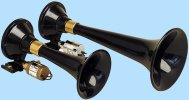If my truck could speak I am sure it would tell me that it was embarrassed by the horn fitted by those people at Fuso.
This is a truck and, in my opinion, it should sound like one when you sound the horn.
Given that I already have an engine driven air compressor and 30 litre receiver fitted in the truck, getting a decent set of air horns seemed to be the logical choice. I must admit, I was quite surprised at how few brands of air horns there are on the market. There did not appear to be any made in Australia, that I could find online, so I had to look overseas.
After spending a bit of time searching the net, the horns I decided on were the Kleinn 220 Dual Train Horns.
I bought mine off eBay and, with freight included, they came to just over two hundred bucks.
I had intended on putting the horns under the cab on the driver’s side, but when I test fitted them there it was obvious that this location was not suitable.
These horns are not small, so the locations for mounting them were somewhat limited. In the end I chose to mount them off the winch mount bracket and have them sit behind the bullbar.
The first thing I had to do was modify my air lines so that that I had an air source for the horns. This involved making some distribution manifolds using 25mm square aluminium bar and some metal push fittings. I made my own manifolds only because I could not find any that suited my requirements. In the end I made four manifolds;
- A one into three – This was the primary air line splitter
- Two for the accessory air lines – One on each side of the truck
- A one into two – For the air horns
The bracket for the horns needed to be relatively strong, as they are reasonably heavy, and the mounting surface needed to slope down slightly, so that the horns would point downward and drain any water that may get into them.
The horn solenoid wires came fitted with bullet connectors, which I changed for waterproof plugs. I also replaced the compression air fittings on the solenoids for push fittings.
The final task was to wire the air horns into the truck’s horn circuit.
It was necessary to unwrap the electrical loom on the steering column in order to get access to the horn’s trigger wire. A connection was made into the trigger wire and this was run to one terminal of an on/off switch on the dash. From the other terminal a wire was run to a relay. This relay supplies power to the air horn solenoids. As with the driving lights, the horn uses negative switching to trigger the relay.
The OEM horn always sounds when the horn switch it pressed, but the air horns can be turned on or off via the switch on the dash.
The reason the horns are wired this way is a safety issue. If the air horns were enabled, but there was no air in the system, the OEM horn would still sound.
Mind you… when the air horns sound, you definitely don’t hear the OEM horn. These things are psychotically loud, punching out over 150dB.
Now the truck sounds like a truck when the horn sounds… 😀
 Click any image to enlarge
Click any image to enlarge





